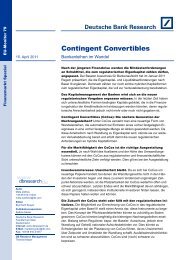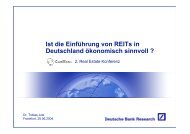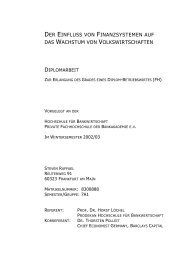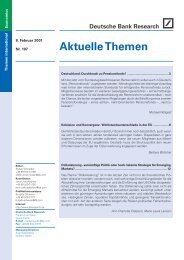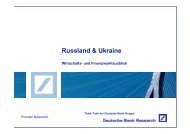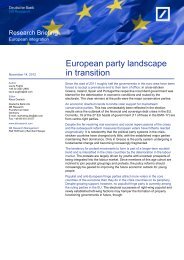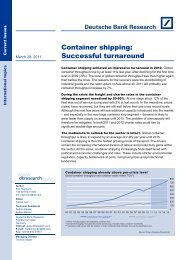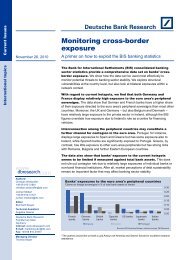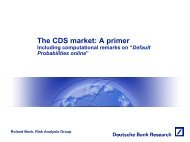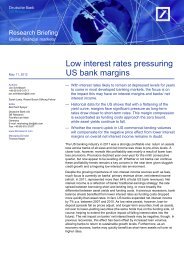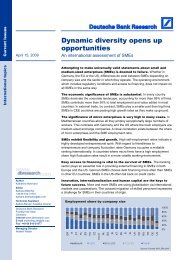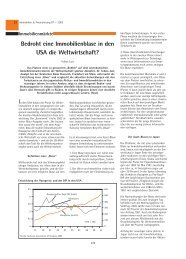Residential construction in Germany - Deutsche Bank Research
Residential construction in Germany - Deutsche Bank Research
Residential construction in Germany - Deutsche Bank Research
Create successful ePaper yourself
Turn your PDF publications into a flip-book with our unique Google optimized e-Paper software.
F<strong>in</strong>d<strong>in</strong>gs of panel regressions depend<strong>in</strong>g<br />
Tob<strong>in</strong>’s q partly distorted by<br />
government <strong>in</strong>tervention<br />
F<strong>in</strong>d<strong>in</strong>gs for German conurbations<br />
Estimates for all cities<br />
Current Issues<br />
The f<strong>in</strong>d<strong>in</strong>gs of the panel analysis are documented <strong>in</strong> Table 6,<br />
categorised accord<strong>in</strong>g to BulwienGesa‗s ABCD city classification<br />
system. 7 It conta<strong>in</strong>s the estimates from calculations <strong>in</strong> which<br />
<strong>in</strong>vestment activity with build<strong>in</strong>g permits <strong>in</strong>clud<strong>in</strong>g measures <strong>in</strong><br />
exist<strong>in</strong>g stock were set aga<strong>in</strong>st the total exist<strong>in</strong>g hous<strong>in</strong>g stock.<br />
Cities All A-rated B-rated C-rated D-rated<br />
Number of cities 95 7 14 21 53<br />
Observations 1,425 105 210 315 795<br />
With<strong>in</strong>-R² 0.20 0.49 0.10 0.20 0.23<br />
Overall-R² 0.17 0.29 0.08 0.20 0.19<br />
Sources: BulwienGesa, Destatis, IW Cologne Institute for Economic <strong>Research</strong>. Notes: The coefficients of q are significant at the 1% level <strong>in</strong> all regressions; all variables<br />
(<strong>in</strong> the total sample and <strong>in</strong> the subsamples) are stationary, i.e. they have a constant mean value and a constant variance over the entire observation period. This is shown<br />
by the Lev<strong>in</strong>-L<strong>in</strong>-Chu test, which rejects the null hypothesis of the existence of a unit root for all variables at all significance levels. 6<br />
To assess the ability of Tob<strong>in</strong>‘s q to describe <strong>in</strong>vestment volume we<br />
use R² statistics. If the coefficient of determ<strong>in</strong>ation is equal to zero,<br />
there is no correlation between Tob<strong>in</strong>‘s q and build<strong>in</strong>g activity, while<br />
if it is equal to one, the model can expla<strong>in</strong> the <strong>in</strong>vestments <strong>in</strong> full.<br />
S<strong>in</strong>ce variances emerge between cities as well as with<strong>in</strong> cities <strong>in</strong><br />
panel analyses, two values are given altogether. The most important<br />
value for fixed-effects estimates, ―with<strong>in</strong>-R²‖, shows how the<br />
changes <strong>in</strong> build<strong>in</strong>g activity can be expla<strong>in</strong>ed by Tob<strong>in</strong>‘s q of a city.<br />
―Overall-R²‖ expla<strong>in</strong>s the mean<strong>in</strong>gfulness of the overall model.<br />
The estimated coefficients and their significance show that, <strong>in</strong> l<strong>in</strong>e<br />
with expectations, Tob<strong>in</strong>‘s q exerts a positive, significant <strong>in</strong>fluence on<br />
<strong>in</strong>vestment activity. 8<br />
The f<strong>in</strong>d<strong>in</strong>gs show that, <strong>in</strong> l<strong>in</strong>e with<br />
expectations, Tob<strong>in</strong>‘s q exerts a positive and significant <strong>in</strong>fluence on<br />
<strong>in</strong>vestment activity. The <strong>in</strong>vestment fluctuations <strong>in</strong> a city can be<br />
expla<strong>in</strong>ed to around 20% altogether on the basis of Tob<strong>in</strong>‘s marg<strong>in</strong>al<br />
q. 9 The explanatory power is considerably higher for A-rated cities,<br />
at 49%, while it is considerably lower for B-rated cities at 10%. For<br />
the smaller C and D-rated cities it is around 20%. This suggests that<br />
the explanatory power of the regressions does not <strong>in</strong>crease or<br />
decrease with the size of the city.<br />
The low coefficients of determ<strong>in</strong>ation are probably not solely<br />
attributable to quality problems with the data, but ma<strong>in</strong>ly to the fact<br />
that Tob<strong>in</strong>‘s q cannot possibly conta<strong>in</strong> all the <strong>in</strong>formation on the<br />
market situation of a given city. Note <strong>in</strong> this case <strong>in</strong> particular the<br />
abolition of the home-ownership grant at the end of 2005. Thanks to<br />
7 A city is categorised with an A, B, C or D rat<strong>in</strong>g accord<strong>in</strong>g to its functional<br />
importance, largely accord<strong>in</strong>g to its population, but also accord<strong>in</strong>g to office<br />
turnover and office stock (www.riwis.de).<br />
8 Because of endogeneity problems the coefficients are not <strong>in</strong>terpreted further.<br />
9 The estimates differ only marg<strong>in</strong>ally depend<strong>in</strong>g on the proxies chosen for<br />
<strong>construction</strong> <strong>in</strong>vestment.By contrast, the regressions with the average q deliver<br />
noticeably poorer results. For the estimates with time-lagged q values it emerges<br />
that current q, as a mirror of the market situation, can give the best reflection of<br />
<strong>in</strong>vestment activity. Furthermore, the explanatory power of the models decl<strong>in</strong>es<br />
when the years 1990 through 1994 are <strong>in</strong>cluded. This may be <strong>in</strong>terpreted as a<br />
gradual return to normality <strong>in</strong> the real estate markets follow<strong>in</strong>g the heavy degree of<br />
government <strong>in</strong>tervention dur<strong>in</strong>g the German unification phase.<br />
6 August 22, 2011



